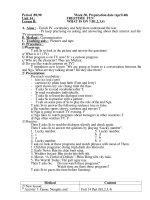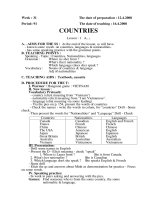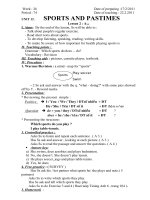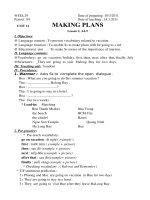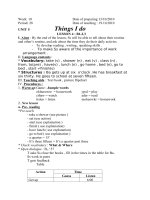Giao An Anh 9
Bạn đang xem bản rút gọn của tài liệu. Xem và tải ngay bản đầy đủ của tài liệu tại đây (120.79 KB, 10 trang )
<span class='text_page_counter'>(1)</span><div class='page_container' data-page=1>
Date of preparing: 22/3/10
Date of teaching: 26/3/10
PERIOD 56 UNIT 9 NATURAL DISASTERS
Lesson 1: Getting started + Listen and read.
I. The aims and requests.
1. Knowledge.
- To help students read a passage about the weather forecast in Viet Nam.
- To help students know that We often use " Will " for weather forecast.
2. Skill.
- To improve students' reading and listening ability.
3. Attitude.
- To make students love learning English and enjoy the lesson.
II. Preparation.
1. Teacher: Lesson plan, CD and CD player ( Laptop and speaker)
2. Ss : read the passage before going to class.
III. Procedure.
1. Checking up previous lesson + Warm up.
<i><b>Warmer: Which countries do you think the following things often happen?</b></i>
Snowstorm
Earthquake
Volcano
Typhoon
2. New lesson.
Teacher's and Students' activities T Content
1. Pre - Teach.
- T uses explanation and
translation to elicit vocab from
students.
- Ss listen , repeat and copy.
- Checking vocab: R & R
- Ss match the pictures with the
correct words.( page 74)
2. Pre - Reading.
- T plays the tape
- Ss listen and read in silence
- Ss practice reading
- T elicits model sentence from
students.
3. While - reading
- T does concept checking.
Meaning
Form
Use
10
7
10
I. Vocabulary.
- (to) turn up vặn to
- the south-central coast bờ biển nam trung bộ
- thunderstorm (n) mưa bão có sấm sét
- the central highlands cao nguyên miền trung
- (to) expect mong chờ
- (to) trust tin tưởng
- temperature (n) nhiệt độ
II. Listen and read.
<i><b>Model sentence.</b></i>
- Ha Noi will have temperatures between 230<sub>c </sub>
and 270<sub> c .</sub>
- It will be raining along the coast of Thanh
Hoa.
</div>
<span class='text_page_counter'>(2)</span><div class='page_container' data-page=2>
- Ss read the passage and do ex b
on page 75 - 76
4. Post - Reading.
- Ss work individually, use WILL
to write the weather forecast for
tomorrow. Begin with:
13
1 - turn up / weather forecast
2. raining 3. South - Central coast
4 - be / have temperatures/ experience
temperatures
5. weather forecast / watching them.
III. Practice.
Tomorrow it will be ...in ....
3. Consolidation: T repeats the content of the lesson, The form and use of The future
simple and future continuous tense.
4. Homework: Ss learn by heart all the vocab, read the passage again carefully ...
5. Homework. ………
Date of preparing:26/3/10
Date of teaching: 30/3/10
PERIOD 57 UNIT 9 NATURAL DISASTERS
Lesson 2: Speak + Listen
I. The aims and requests.
1. Knowledge.
- To give students chance to practice speaking about what preparations should be made
for a typhoon.
- To help students listen to a talk about what to do when living in an earthquake zone.
2. Skill.
- To develop students' speaking and listening ability.
3. Attitude.
- To make students love learning English and enjoy the lesson.
II. Preparation.
1. Teacher: Lesson plan, Laptop and a speaker.
2, Students: do their assignments before going to class.
III. Procedure.
1. Checking up previous lesson + Warm up.
Warmer: - Brainstorm a list of natural disasters ( flood, volcano…)
- Hangman: E A R T H Q U A K E
2. New lesson.
<b>Teacher's and students' activities</b> T <b>Content</b>
1. Pre - Teach.
- T uses explanation and
translation to elicit vocab from
students.
- Ss listen, repeat and copy
- Checking vocab: R & R
10 I. Vocab.
- (to) block khóa, chặn
- roller (n) con lăn
- plastic container (n) thùng nhựa
- earthquake zone (n) vùng hay xảy ra động đất
- door latches (n) then cửa
</div>
<span class='text_page_counter'>(3)</span><div class='page_container' data-page=3>
2. Pre - speaking.
- Ss work in pairs, think of the
questions to complete the dialogue
between Lan and her mother.
- Ss practice the dialogue
3. While - Speaking.
- Ss work in pairs
St1: make a list of things to buy
and to do to prepare for a typhoon.
<i><b>St 2: Make questions about what to</b></i>
buy and what to do and why
- Ss make their own dialogue
4. Pre - Listening.
<i><b>Pre - questions.</b></i>
- Ss read the questions and think of
the answers.
-5. While - Listening.
- Ss listen to the tape and do the
gap fill first.
- T gets feedback on the board.
- Ss listen again and answer the
questions.
- T gets feedback form ss.
6. Post - speaking and listening.
- SS work in pairs.
- Ss1: is a man / woman who lives
in an earthquake zome.
- Ss2: is an interviewer
15
10
5
- ladder (n)
II. Speak.
A: I think we whould buy some canned food
before a typhoon.
B: Yes, I think so too/ I agree with you. The
market will be closed and no food will be
avialable.
A: I think we should buy a ladder.
B: Why ? / What for?
A: Just in case we need to fix the roof.
Because there must be strong win blowing.
III. Listen.
1. In which countries do earthquake often
occur?
2. What happens when earthquake occurs?
3. What damage can earthquake cause?
4. What should people do in case of
earthquake?
<i><b>Anwer key to Listen. ( gap fill)</b></i>
1………
2. ………..
3. ……….
4. ……….
5. ……….
6. ……….
7. ………..
8. ……….
9. ……….
Eg:
</div>
<span class='text_page_counter'>(4)</span><div class='page_container' data-page=4>
Make a conversation about what
people who live in an earthquake
xone usually do
3. Consolidation: T repeats the content of the listening and speking lesson: What to do
to prepare for a typhoon or an earthquake.
4. Homework: Ss learn by heart all the vocab and make make up dialogues about how
to deal with an earthquake or a typhoon.
5. T's comments on the lesson: ……….
………
Date of preparing:29/3/10
Date of teaching: 1/4/10
PERIOD 58 UNIT 9 NATURAL DISASTERS
Lesson 3: Read
I. The aims and requests.
1. Knowledge.
- To hepl students read a passage about some kinds of natural disasters to understand the
details.
- To provide students with some natural disaster vocabulary.
2. Skill.
- To develop students' reading ability.
3. Attitude.
- To make students love learning English and enjoy the lesson.
II. Preparation.
1. Teacher: Lesson plan, an extra - board. ( a laptop and a projector)
2. Students: read through the passage before going to class.
III. Procedure.
1. Checking up previous lesson + Warm up.
Warm up: SS name any natural disasters that usually bring severe damage to
people
Eg: flood , drought, earthquakes.
2. New lesson.
Teacher's and Students' activities T Content
1. Pre - teach.
- T uses explanation an translation to
elicit vocab from students.
- Ss listen, repeat and copy
- Checking vocab: Matching
2. Pre - reading.
10 I. Vocab.
- (to) coll<b>a</b>pse sập , đổ
- (to) erupt phun
- (to) warn cảnh báo
- (to) suck up hút
</div>
<span class='text_page_counter'>(5)</span><div class='page_container' data-page=5>
Discussion: Ss look at the three
pictures on page 78 and discuss what
is happening there
3. While - Reading.
- Ss read the passage and check their
prediction.
- Ss read the passage again and do ex
b on page 79: Complete the
sentences.
- T and Ss check the completed
sentences
4. Post - Reading.
- Ss work in pairs , choose one of the
disasters mentioned in the text then
ask and answer about it.
5
15
10
II. Read.
T/ F Prediction
<i><b>Answer key.</b></i>
1- T 2 - T 3 - F 4 - T 5 - F 6 - T
<i><b>Answer key.</b></i>
1. The majority of earthquakes occur in
around the Pacific Rim, known as the ring
of fire.
2. During the earthquake in Kobe, many
people were killed when homes, office
blocks and highway collapsed.
3. A tidal wave can only accur when there
is an abrupt shift in the underwater
movement of the earth.
4. In Australia, a tropical storm is known as
a cyclone.
5. A tornado is a type of storm that has a
funnel shape and sucks up anythingg in its
way.
III. Practice.
S1: Can you predict when the volcano will
erupt?
S2: Yes, I can
S1: ………
3. Consolidation. T repeats the main ideas from the passage, tidal wave, tonado, volcano
Typhoon…..
4. Homework: Ss learn by heart all the vocab, read the passage again carefully and try to
retell the content
</div>
<span class='text_page_counter'>(6)</span><div class='page_container' data-page=6>
Date of prepring:2/4/10
Date of teaching:6/4/10
PERIOD 59 UNIT 9 NATURAL DISASTERS
Lesson 4: Write
I. The aims and requests.
1. Knowledge.
- To help students write a story using pictures and word cues.
- By the end of the lesson, students will be able to write a story about a storm.
2. Skill.
- To develop students' writing ability.
3. Attitude.
- To make students love learning English and enjoy the lesson.
II. Preparation.
1. Teacher: Lesson plan, and extra - board.( a laptop and a projector)
2. Students: do their assignments before going to class.
III. Procedure.
1. Checking up previous lesson + Warm up.
Kim's game:
- T gives students one minute to look at the picture s on page 80 . Then they close the
books and try to remember what people in each picutures are doing. ( Vietnamese)
- T gets feedback from students.
2. New lesson.
<b>Teacher's and students' activities</b> <b>T</b> <b>Content</b>
1. Pre - Teach.
- T uses explanation to elicit vocab
from students.
- Ss listen, repeat and copy.
- Checking vocab: Rub out and
remember.
2. Pre - Writing.
- Ss look at all the pcitures in their
books and guess what the story is
about
- T gets feedback on the board.
- Ss make sentences about each
picture using the words in the box on
page 79
3. While - Writing.
- Ss write a story by adding some
10
10
15
I. Vocab.
- (to) shine chiếu sáng, tỏa sáng
- perfect (adj) hoàn hảo
- (to) behave đối xử, cư xử
- circle (n) vòng tròn
- (to) hear nghe thấy
- (to) gather tập trung
- shelter (n) chỗ ẩn nấp
Scared (adj) sợ hãi
II. Write.
Eg: Lan was playing with her dog.
The dog behaved strangely..
………
<i><b>Suggested writing.</b></i>
</div>
<span class='text_page_counter'>(7)</span><div class='page_container' data-page=7>
more sentences and connecting them
with suitalbe connectives.
- T goes around the class to help
students write the story.
4. Post - Writing.
Correction: Ss swap the notebooks
and correct each other's mistakes.
5
shining, the sky was blue, and the weather
was perfect. Lan was outside playing with
her dog, Skippy. All of a sudden, the dog
began behaving strangely. She kept running
around in circles. Lan ran home with the dog
to tell her mother what Skippy was doing.
Lan's mother - Mrs. Quyen, told Lan that
she heard on TV that there was a typhoon
coming. Mrs. Quyen gathered her family
and told the to find shelter in ther home.
Suddenly, the sky became very dark. The
storm came with strong winds and heavy
rain. Mrs Quyen and her family were
scared . But soon the storm finished and
everyone was glad. What a clever dog
Skippy is. She saved Lan from being caught
in the typhoon.
3. Consolidation: T repeats the content of the story and the way to write a story.
4. Homework: Ss learn by heart all the vocab, and rewrite the story.
</div>
<span class='text_page_counter'>(8)</span><div class='page_container' data-page=8>
Date of preparing:10/4/10
Date of teaching: 13/4/10
PERIOD 60 UNIT 9 NATURAL DISASTERS
Lesson 5: Language Focus.
I. The aims and requests.
1. Knowledge.
- To help students distinguish between Defining and Non-Defining Relative clauses.
- By the end of the lesson, Students will be able deeply understand the use and form of
Relative Clauses and do all the exercises in their textbooks correctly.
2. Skill.
- To improve students' English grammar.
3. Attitude.
- To make students love learning English and enjoy the lesson.
II. Preparation.
1. Teacher: Lesson plan, an extra-board.
2. Students: do their assignements before going to class.
III. Procedure.
1. Checking up previous lesson + Warm up.
T checks SS' writing at home.
2. New lesson.
<b>Teacher's and students'</b>
<b>activities</b>
<b>T</b> <b>Content</b>
1. Pre - Teach.
- T uses expalanation and
translation to elicit vocab from
students.
- Ss listen, repeat and copy.
- Checking vocab: Rub out and
Remember.
2. Presentation.
a. Defining Relative clauses.
- T gives some model sentences
and explains the form and use of
Relative pronouns in Relative
clauses.
- Ss listen and the do Ex 1 on
page 81 - Textbook.
10
10
20
I. Vocab.
- snout (n) mũi
- rhinoceros (n) con tê giác
- venus (n) sao kim
- (to) discover khám phá ra, tìm ra
- explorer (n) nhà thám hiểm
- (to) Chew nhai
- Chewing gum (n) kẹo cao
- (to) swallow nuốt
- disastrous (adj) thảm khốc
II. Relative clauses.
1. Defining Relative clause.
Eg: -The city which was struck by a huge
earthquake in 1995 in Japan is Kobe.
- The country which won the 1998 Tiger cup is
Singapore.
2. Non- Defining Relative Clauses.
</div>
<span class='text_page_counter'>(9)</span><div class='page_container' data-page=9>
b. Non - Defining clause.
- T gives some model sentences
and explanes the use and form of
Non-definign relative clauses.
- Ss copy and do exercises.
- Ss go on with ex 3 and 4.
2-g: It snowed in Lang Son, which is on the Ky
Cung River, in the summer of 2002.
3 - f: Pompeii, which is an ancient city of Italy,
was completely destroyed in A.D. 79 by an
eruption of Mount Vesuvius.
4-a: Hurricane Andrew, which swept through
Southern Florida in August 1992, killed 41
people and made more than 200,000 homeless.
5-c: The cyclone of November 1970 in
Bangladesh , which killed about 500,000
people, was one of the worst natural disasters of
the 29th<sub> century.</sub>
6-d: The most disastrous earthequake in
Japanese history, which occurred in 1923,
damaged Tokyo and Yokohama and killed
about 150,000 people.
7-b. The October 1980 Loma Prieta earthquake,
which measured 7.1 on the Richter scale ,
caused extensive damage to older buildings ton
San Fransisco Bay area.
3. Consolidation: T repeats the form and use of Defining and Non-defining relative
clauses.
4. Homework: Ss do all the exercies above again.
5. T's comments on the lesson: ………..
Date of preparing:10/4/10
Date of teaching: 14/4/10
PERIOD 61 REVISION
I. The aims and requests.
1. Knowledge.
- To give students chance to fyrtherly practice in Relative clauses ( Defining and
Non-defining Relative clause)
2. Skill.
- To improve students' English grammar.
3. Attitude.
- To make students love learning English and enjoy the lesson.
II. Preparation.
1. Teacher: Lesson plan, textbook , workbook.
2. Students: do their assignements in advance.
III. Preparation.
</div>
<span class='text_page_counter'>(10)</span><div class='page_container' data-page=10>
- T check the exercises in precious lesson.
2. New lesson.
Teacher's and students' activities T Contents
1. Activity 1:
- T and students correct exercise3
on page 82 textbook.
-After correcting, Ss copy all the
ex in their notebooks.
2. Activity 2.
- Ss do ex 6 (on page 62
workbook.): Ss study the map of
the USA and read the descriptions.
Match the name of the state with
the right descriptiond given.
10
15
15
<i><b>1.Exercises 3 (on page 82 textbook.)</b></i>
<i><b>Answer key.</b></i>
b. Kangaroos, <i>which come from Australia</i>,
have long tails.
c. Ba, <i>who lives on Trang Tien street</i>, likes
playing the guitar.
d. ( Defining)
e. Neil Amstrong, <i>who first walked on the </i>
<i>moon</i>, lived in the USA.
f. ( defining)
g. Miss. Lien, <i>who sings very well</i>, is my
English teacher.
<i><b>2. Ex 6 ( on page 62 workbook).</b></i>
1- d 2 - f 3 - c 4 - a 5 - e 6 - h 7 - g
8 - b.
<i><b>3. Ex 7 ( on page 62 workbook)</b></i>
Fill in each gap with ONE suitable word.
1 - in 2 - agricultural 3 - of 4 - produced
5- which 6 - until 7 - struck 8 - caused
9 - broke 10 - more.
3. Consolidation : T repeats the use and form of defining and Non- defining relative
clause.
4. Homework: Ss so all the exercise above again to make preparation for the wriiten test.
4. T's comments o the lesson: ………..
</div>
<!--links-->
